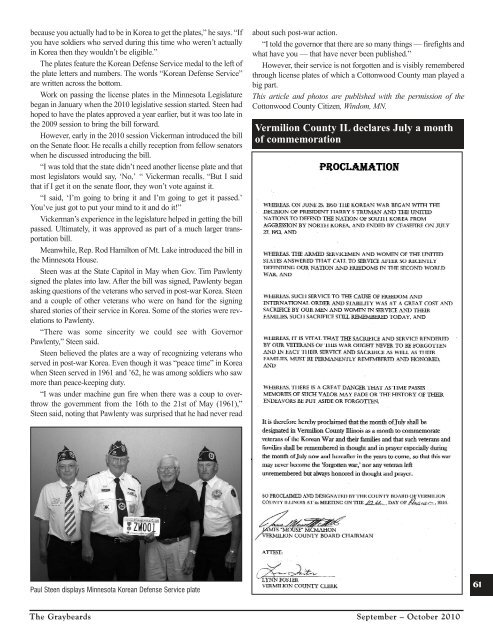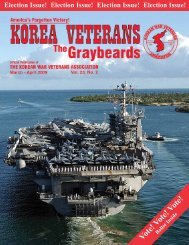Graybeards - Korean War Veterans Association
Graybeards - Korean War Veterans Association
Graybeards - Korean War Veterans Association
You also want an ePaper? Increase the reach of your titles
YUMPU automatically turns print PDFs into web optimized ePapers that Google loves.
ecause you actually had to be in Korea to get the plates,” he says. “If<br />
you have soldiers who served during this time who weren’t actually<br />
in Korea then they wouldn’t be eligible.”<br />
The plates feature the <strong>Korean</strong> Defense Service medal to the left of<br />
the plate letters and numbers. The words “<strong>Korean</strong> Defense Service”<br />
are written across the bottom.<br />
Work on passing the license plates in the Minnesota Legislature<br />
began in January when the 2010 legislative session started. Steen had<br />
hoped to have the plates approved a year earlier, but it was too late in<br />
the 2009 session to bring the bill forward.<br />
However, early in the 2010 session Vickerman introduced the bill<br />
on the Senate floor. He recalls a chilly reception from fellow senators<br />
when he discussed introducing the bill.<br />
“I was told that the state didn’t need another license plate and that<br />
most legislators would say, ‘No,’ “ Vickerman recalls. “But I said<br />
that if I get it on the senate floor, they won’t vote against it.<br />
“I said, ‘I’m going to bring it and I’m going to get it passed.’<br />
You’ve just got to put your mind to it and do it!”<br />
Vickerman’s experience in the legislature helped in getting the bill<br />
passed. Ultimately, it was approved as part of a much larger transportation<br />
bill.<br />
Meanwhile, Rep. Rod Hamilton of Mt. Lake introduced the bill in<br />
the Minnesota House.<br />
Steen was at the State Capitol in May when Gov. Tim Pawlenty<br />
signed the plates into law. After the bill was signed, Pawlenty began<br />
asking questions of the veterans who served in post-war Korea. Steen<br />
and a couple of other veterans who were on hand for the signing<br />
shared stories of their service in Korea. Some of the stories were revelations<br />
to Pawlenty.<br />
“There was some sincerity we could see with Governor<br />
Pawlenty,” Steen said.<br />
Steen believed the plates are a way of recognizing veterans who<br />
served in post-war Korea. Even though it was “peace time” in Korea<br />
when Steen served in 1961 and ’62, he was among soldiers who saw<br />
more than peace-keeping duty.<br />
“I was under machine gun fire when there was a coup to overthrow<br />
the government from the 16th to the 21st of May (1961),”<br />
Steen said, noting that Pawlenty was surprised that he had never read<br />
about such post-war action.<br />
“I told the governor that there are so many things — firefights and<br />
what have you — that have never been published.”<br />
However, their service is not forgotten and is visibly remembered<br />
through license plates of which a Cottonwood County man played a<br />
big part.<br />
This article and photos are published with the permission of the<br />
Cottonwood County Citizen, Windom, MN.<br />
Vermilion County IL declares July a month<br />
of commemoration<br />
Paul Steen displays Minnesota <strong>Korean</strong> Defense Service plate<br />
61<br />
The <strong>Graybeards</strong><br />
September – October 2010

















